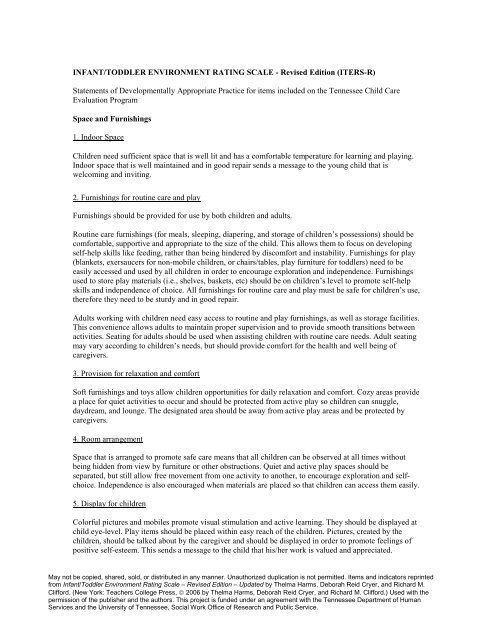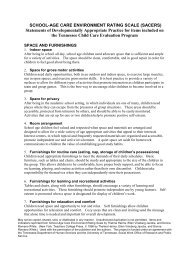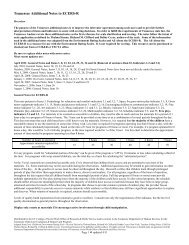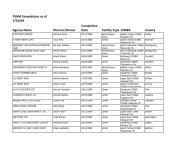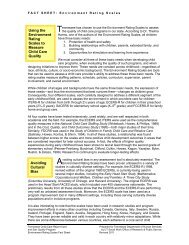INFANT/TODDLER ENVIRONMENT RATING SCALE - Star-Quality ...
INFANT/TODDLER ENVIRONMENT RATING SCALE - Star-Quality ...
INFANT/TODDLER ENVIRONMENT RATING SCALE - Star-Quality ...
You also want an ePaper? Increase the reach of your titles
YUMPU automatically turns print PDFs into web optimized ePapers that Google loves.
<strong>INFANT</strong>/<strong>TODDLER</strong> <strong>ENVIRONMENT</strong> <strong>RATING</strong> <strong>SCALE</strong> - Revised Edition (ITERS-R)<br />
Statements of Developmentally Appropriate Practice for items included on the Tennessee Child Care<br />
Evaluation Program<br />
Space and Furnishings<br />
1. Indoor Space<br />
Children need sufficient space that is well lit and has a comfortable temperature for learning and playing.<br />
Indoor space that is well maintained and in good repair sends a message to the young child that is<br />
welcoming and inviting.<br />
2. Furnishings for routine care and play<br />
Furnishings should be provided for use by both children and adults.<br />
Routine care furnishings (for meals, sleeping, diapering, and storage of children’s possessions) should be<br />
comfortable, supportive and appropriate to the size of the child. This allows them to focus on developing<br />
self-help skills like feeding, rather than being hindered by discomfort and instability. Furnishings for play<br />
(blankets, exersaucers for non-mobile children, or chairs/tables, play furniture for toddlers) need to be<br />
easily accessed and used by all children in order to encourage exploration and independence. Furnishings<br />
used to store play materials (i.e., shelves, baskets, etc) should be on children’s level to promote self-help<br />
skills and independence of choice. All furnishings for routine care and play must be safe for children’s use,<br />
therefore they need to be sturdy and in good repair.<br />
Adults working with children need easy access to routine and play furnishings, as well as storage facilities.<br />
This convenience allows adults to maintain proper supervision and to provide smooth transitions between<br />
activities. Seating for adults should be used when assisting children with routine care needs. Adult seating<br />
may vary according to children’s needs, but should provide comfort for the health and well being of<br />
caregivers.<br />
3. Provision for relaxation and comfort<br />
Soft furnishings and toys allow children opportunities for daily relaxation and comfort. Cozy areas provide<br />
a place for quiet activities to occur and should be protected from active play so children can snuggle,<br />
daydream, and lounge. The designated area should be away from active play areas and be protected by<br />
caregivers.<br />
4. Room arrangement<br />
Space that is arranged to promote safe care means that all children can be observed at all times without<br />
being hidden from view by furniture or other obstructions. Quiet and active play spaces should be<br />
separated, but still allow free movement from one activity to another, to encourage exploration and selfchoice.<br />
Independence is also encouraged when materials are placed so that children can access them easily.<br />
5. Display for children<br />
Colorful pictures and mobiles promote visual stimulation and active learning. They should be displayed at<br />
child eye-level. Play items should be placed within easy reach of the children. Pictures, created by the<br />
children, should be talked about by the caregiver and should be displayed in order to promote feelings of<br />
positive self-esteem. This sends a message to the child that his/her work is valued and appreciated.<br />
May not be copied, shared, sold, or distributed in any manner. Unauthorized duplication is not permitted. Items and indicators reprinted<br />
from Infant/Toddler Environment Rating Scale – Revised Edition – Updated by Thelma Harms, Deborah Reid Cryer, and Richard M.<br />
Clifford. (New York: Teachers College Press, 2006 by Thelma Harms, Deborah Reid Cryer, and Richard M. Clifford.) Used with the<br />
permission of the publisher and the authors. This project is funded under an agreement with the Tennessee Department of Human<br />
Services and the University of Tennessee, Social Work Office of Research and Public Service.
Personal Care Routines<br />
6. Greeting/Departing<br />
Parents and children need a warm, welcoming, and pleasant atmosphere to make the daily greeting and<br />
departing routine a happy one. Positive greetings help to promote the children's self-esteem and create a<br />
welcoming environment for parents. Parents should enter the classroom with their child and should be able<br />
to move around the room freely. Caregivers should be sensitive to separation anxiety by parents and<br />
children alike. The child's daily schedule should be made available to the parents.<br />
7. Meals/Snacks<br />
Meals and snacks that follow USDA guidelines contribute to the health of children and provide a model for<br />
good nutritional habits for life-long practice. Proper hand washing and careful food preparation both teach<br />
children proper hygiene and promote sanitary conditions. Children’s safety is a concern during mealtimes.<br />
Precautions should include posting of food allergies and making necessary food substitutions. In addition,<br />
children need to be carefully supervised while eating or held while taking bottles. Mealtimes should be<br />
relaxed and scheduled to meet children’s individual needs.<br />
8. Nap<br />
Naptime should be scheduled to suit the individual needs of children. Each child should have his/her own<br />
crib/mat separated from others to help prevent the spread of germs. Caregivers should stay alert to handle<br />
potential problems that arise and to help provide a peaceful rest/nap time for young children.<br />
9. Diapering/Toileting<br />
Young children need appropriate supervision of the toileting process in order to care for basic needs and to<br />
teach the importance of good health habits. As children are ready, parents and caregivers should work<br />
together to introduce toileting practices that encourage positive self-concept and self-esteem. The schedule<br />
should be individualized. Provisions, such as soap and steps near the sink, should be convenient and<br />
accessible so that children can wash hands or have their hands washed after toileting; this promotes selfhelp<br />
skills and good personal hygiene. Diapering should always be managed in a manner that promotes<br />
safety and good health practices.<br />
10. Health practices<br />
When caring for young children, caregivers must take action to prevent potential health problems and<br />
promote positive health habits. Since young children are especially vulnerable to illnesses, caregivers<br />
should be alert to handle children’s health needs. Medicines should be administered appropriately.<br />
Preventative measures should be practiced with consistency. Prevention includes properly washing hands<br />
after handling pets, wiping noses, etc. The spread of germs should be minimized by providing children with<br />
clean toys, contaminate free sandboxes, and clean classroom surfaces. Protecting children’s health includes<br />
taking appropriate actions to remove sick children from contact with others. Children should be provided<br />
with a change of clothes if needed due to accidents, weather conditions, or messy play.<br />
Caregivers are great role models for promoting positive health habits. They are a valuable resource in<br />
educating young children about life-long health practices that prevent illness and promote good health.<br />
Caregivers should model and encourage self-help skills through activities where children are actively<br />
involved and encouraged to be interested in learning personal hygiene.<br />
May not be copied, shared, sold, or distributed in any manner. Unauthorized duplication is not permitted. Items and indicators reprinted<br />
from Infant/Toddler Environment Rating Scale – Revised Edition – Updated by Thelma Harms, Deborah Reid Cryer, and Richard M.<br />
Clifford. (New York: Teachers College Press, 2006 by Thelma Harms, Deborah Reid Cryer, and Richard M. Clifford.) Used with the<br />
permission of the publisher and the authors. This project is funded under an agreement with the Tennessee Department of Human<br />
Services and the University of Tennessee, Social Work Office of Research and Public Service.
11. Safety practice<br />
Protecting children is critical in providing quality care, whether through adequate supervision or<br />
minimizing hazards both inside and outside. Caregivers should anticipate potential safety problems and<br />
demonstrate, model, and teach children safe practices.<br />
Listening and Talking<br />
12. Helping children understand language<br />
The importance of exposing children to language, even very young children, cannot be emphasized enough.<br />
Children’s early language experiences influence many areas of their development. Language is best<br />
understood when modeled by caregivers who are attentive and talk to children in a warm, supportive<br />
manner. Children need to be talked to frequently with simple, exact words. Children learn language within<br />
meaningful contexts where adults name objects and describe what children are doing and feeling.<br />
13. Helping children use language<br />
Children, as well as adults, use language to communicate their needs. Children’s initial use of language is<br />
often expressed in their cries and sounds. As children grow in their understanding of language, their<br />
language becomes more distinguishable as words and phrases. When adults show interest in understanding<br />
what the child is trying to communicate, language is encouraged because the child learns their voice is<br />
heard and has meaning. This “give and take” is an early form of turn taking in communication. Children<br />
feel valued when adults respond in a positive, timely manner to their use of language. Adults also become<br />
language models by describing their own actions, introducing children to new words, and asking children<br />
questions.<br />
14. Using books<br />
The use of books and pictures with infants and toddlers is an important means of language learning for<br />
children as they make sense of the world around them. Books and pictures should be available in sufficient<br />
number for both independent use and use by a caregiver with the children. Early experiences with books,<br />
such as when caregivers are involved and interact warmly with children, encourage continued interest in<br />
literacy. Literacy is further encouraged when books are kept in good repair, thus sending the message that<br />
books are a valued resource. Children should be allowed to choose from a wide variety of age-appropriate<br />
books. The use of sturdy vinyl, cloth, or hard page books make them easier for children to explore<br />
independently.<br />
Activities<br />
15. Fine motor<br />
Infants and toddlers need a variety of age-appropriate toys and materials that they can manipulate and play<br />
with at will. Materials should be in good repair, organized for play, and stimulate children at different skill<br />
levels. These activities strengthen fine motor control while encouraging and reinforcing skill development<br />
that contributes to academic readiness.<br />
16. Active physical play<br />
Young children need ample opportunity to exercise their gross motor skills. Opportunities for active play<br />
should be available both indoors and outdoors. Age-appropriate equipment and materials should present<br />
interesting and challenging options and should be supervised by attentive caregivers.<br />
May not be copied, shared, sold, or distributed in any manner. Unauthorized duplication is not permitted. Items and indicators reprinted<br />
from Infant/Toddler Environment Rating Scale – Revised Edition – Updated by Thelma Harms, Deborah Reid Cryer, and Richard M.<br />
Clifford. (New York: Teachers College Press, 2006 by Thelma Harms, Deborah Reid Cryer, and Richard M. Clifford.) Used with the<br />
permission of the publisher and the authors. This project is funded under an agreement with the Tennessee Department of Human<br />
Services and the University of Tennessee, Social Work Office of Research and Public Service.
17. Art<br />
Young children benefit from exposure to child-initiated art activities that are open-ended and process<br />
oriented. Children's art should be respected and appreciated as individual creative expression. Materials and<br />
opportunities to create art projects at a beginning level should be available as children are developmentally<br />
ready for them.<br />
18. Music and movement<br />
Music and movement are valuable means of learning and expression. Children’s educational and<br />
developmental needs are better met when recorded music is used purposefully. Children need supportive<br />
caregivers that encourage self-expression and free choice in music and movement experiences.<br />
19. Blocks<br />
Block play, with a variety of blocks and accessories, allows young children the opportunity to explore<br />
spatial, mathematical, and role-play possibilities. Block play requires sufficient space in a protected area<br />
and time to expand on concepts and ideas.<br />
20. Dramatic play<br />
Dramatic play gives children opportunity to discover an array of roles and responsibilities as well as<br />
providing a vehicle through which they make sense of their world. Space, time, props, materials, and<br />
supportive caregivers enhance dramatic play.<br />
21. Sand and water play<br />
Sand and water play gives young children the opportunity to learn concepts through active exploration with<br />
their senses. The learning potential is extended when a variety of toys and different activities are used with<br />
sensory play.<br />
22. Nature/ science<br />
Even young children can appreciate the wonders of the natural world. Children need experiences with<br />
natural things both indoors and outdoors. Children benefit from hands-on experiences with the weather,<br />
natural objects, living things, etc. Realistic portrayals of nature in books, pictures, and toys enhance<br />
children’s understanding of their world.<br />
23. Use of TV, video, and/ or computer<br />
Since children benefit more from hands-on experiences, the use of television, video, or computers is not<br />
recommended for infants and should be limited if used with toddlers. Children’s experiences are enhanced<br />
when caregivers are involved in viewing and limit materials to those that are appropriate and educational. If<br />
media materials are used alternative activities should be available to children.<br />
24. Promoting acceptance of diversity<br />
Children need to learn about similarities and differences and acceptance by exposure to diversity through<br />
pictures, books, dolls, and other materials. Activities and classroom interactions are valuable resources as<br />
well. Exposure to diversity among peoples encourages respect for others and lessens misunderstandings.<br />
May not be copied, shared, sold, or distributed in any manner. Unauthorized duplication is not permitted. Items and indicators reprinted<br />
from Infant/Toddler Environment Rating Scale – Revised Edition – Updated by Thelma Harms, Deborah Reid Cryer, and Richard M.<br />
Clifford. (New York: Teachers College Press, 2006 by Thelma Harms, Deborah Reid Cryer, and Richard M. Clifford.) Used with the<br />
permission of the publisher and the authors. This project is funded under an agreement with the Tennessee Department of Human<br />
Services and the University of Tennessee, Social Work Office of Research and Public Service.
Interaction<br />
25. Supervision of play and learning<br />
Supervision of infants and toddlers means meeting individual needs with a flexible schedule and providing<br />
for a variety of play activities. Caregivers should be tuned in to routine needs, but also should recognize the<br />
need for a balance of quiet and active experiences. Caregivers should provide and watch over the use of<br />
materials that stimulate the senses and interests of children.<br />
26. Peer interaction<br />
Infants and toddlers begin to learn how to interact socially and engage in peer experiences when they are<br />
allowed to move freely and encouraged to develop positive peer relationships. Caregivers need to promote<br />
early social skills by guiding and reinforcing the positive efforts of children interacting with each other.<br />
27. Staff-child interaction<br />
Caregivers, who are nurturing and responsive, promote the development of mutual respect between<br />
children and adults. Children, who trust adults to provide for their physical, psychological, and emotional<br />
needs, develop their own sense of self-worth and self-esteem.<br />
28. Discipline<br />
Infants and toddlers, who are nurtured with appropriate expectations and who experience consistency in<br />
disciplinary care, receive the first lessons in managing their own behavior and learning self-control. A<br />
stimulating environment in which rules are simple, explained, and consistently enforced is key to managing<br />
discipline and promoting good behavior.<br />
Program Structure<br />
29. Schedule<br />
Infants and toddlers thrive on a consistent routine that provides a balance of activities designed to meet<br />
individual needs and foster physical, cognitive, social, and emotional growth. Play activities, basic routines,<br />
and transitions provide opportunities for learning and growing.<br />
30. Free play<br />
When children are permitted to select materials and companions, and, as far as possible, manage play<br />
independently, they learn to make their own choices, tailoring their learning to their personal needs. When<br />
giving opportunities to explore, children will choose to play and learn in the way that is most effective for<br />
their own personality by following their interests and working on the skills that they really need to develop.<br />
Caregiver intervention should be in response to children's needs, an invitation, or an opportunity to expand<br />
play activities.<br />
31. Group play activities<br />
In group-care situations, the focus needs to be on meeting individual needs and guiding children as they<br />
interact in small groups. If whole group activities are used, they should be limited to a small number of<br />
children, limited in time, and flexible to allow for the individual interests of all children.<br />
May not be copied, shared, sold, or distributed in any manner. Unauthorized duplication is not permitted. Items and indicators reprinted<br />
from Infant/Toddler Environment Rating Scale – Revised Edition – Updated by Thelma Harms, Deborah Reid Cryer, and Richard M.<br />
Clifford. (New York: Teachers College Press, 2006 by Thelma Harms, Deborah Reid Cryer, and Richard M. Clifford.) Used with the<br />
permission of the publisher and the authors. This project is funded under an agreement with the Tennessee Department of Human<br />
Services and the University of Tennessee, Social Work Office of Research and Public Service.
32. Provisions for children with disabilities<br />
Meeting the needs of infants and toddlers with disabilities requires knowledge of routine care needs,<br />
individual assessments, developmental levels, and the integration of the children in ongoing classroom<br />
activities. It also requires the involvement and establishment of a partnership between the parents and staff<br />
in setting attainable goals that will assist the child in reaching his/her full potential.<br />
May not be copied, shared, sold, or distributed in any manner. Unauthorized duplication is not permitted. Items and indicators reprinted<br />
from Infant/Toddler Environment Rating Scale – Revised Edition – Updated by Thelma Harms, Deborah Reid Cryer, and Richard M.<br />
Clifford. (New York: Teachers College Press, 2006 by Thelma Harms, Deborah Reid Cryer, and Richard M. Clifford.) Used with the<br />
permission of the publisher and the authors. This project is funded under an agreement with the Tennessee Department of Human<br />
Services and the University of Tennessee, Social Work Office of Research and Public Service.


